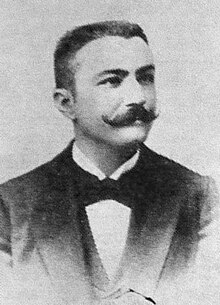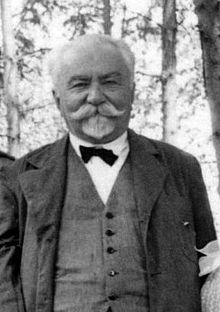Emil Racoviță
Emil Racoviță (born November 15, 1868 in Iași , † November 17, 1947 in Cluj ) was a Romanian biologist , botanist and founder of biospeleology (cave research). He was a member and president (1926–1929) of the Romanian Academy of Sciences and professor at the University of Cluj .
Origin and education
Emil Racoviță came from the important Moldovan aristocratic family Racoviță , whose members ascended the Moldovan and Wallachian thrones several times in the 18th century : Mihai Racoviță , Constantin Racoviță and Ștefan Racoviță . Emil Racoviță spent most of his childhood in Sorăneşti, Vaslui, and was a student of Ion Creangă . Through his teacher Grigore Cobălcescu at the Lyceum "Institutele Unite" in Iași, he discovered his passion for the natural sciences.
At the request of his father, he first studied law in Paris , then in 1891 again devoted himself entirely to the natural sciences at the Sorbonne and in 1896 completed his doctoral thesis under Henri de Lacaze-Duthiers . As a student, he led the socialist student circle in Paris for many years, where the basic theses of scientific socialism were discussed. Due to his political conviction that “the land must belong to whoever tills it”, he distributed most of his inherited goods to the farmers.
Belgica expedition
Emil Racoviță took part in the Belgian Antarctic Expedition (1897 to 1899) on the Belgica as a biologist . The expedition was led by Adrien de Gerlache de Gomery ; The second officer was Roald Amundsen , who was still completely unknown at the time . Emil Racoviță put together an impressive botanical and zoological collection of over 1,600 species during this expedition. His research on whales is now considered a classic. His diary of the expedition mentions the great physical and psychological torment they endured. His scientific results of the research trip were published in 1900 under the title La vie des animaux et des plantes dans l'Antarctique (The life of animals and plants in the Antarctic). In memory of his achievements on this research trip, the Racoviță Islands in Antarctica have been named after him since 1958 .
Life
Henri de Lacaze-Duthiers appointed him deputy director at the marine research station "Arago" in Banyuls-sur-Mer and the Sorbonne . Emil Racoviță became co-editor of the international journal Archives de zoologie experimentale et generale .
During a visit to Mallorca in 1904, he discovered a new type of cancer in the Cueva del Drach and from then on devoted himself to researching underground ecosystems . In 1907 he published the Essai sur les problemes biospeologiques , the world's first scientific work on biospaeology, which marked the birth of the new science.
At the University of Cluj , today's Babes-Bolyai University , he founded the world's first Institute of Speleology the 1920s. Emil Racoviță defined biospelaeology as the science of life in caves and underground waters and his research on ecology and evolution, the adaptation of the animal world to the living conditions in the subsurface and the systematics of the animal world are milestones in science.
The results of his biosphaeological program are remarkable: more than 1,400 caves in Europe and Africa were explored and a collection of 50,000 cave animals was created and 66 publications with a total of almost 6,000 pages on the underground fauna were written.
In 1940 Romania had to cede the north and east of Transylvania to Hungary due to the second Vienna arbitration . Then Emil Racoviță and the Speleological Institute moved briefly to Timișoara . After the resignation of the territory, the institute was relocated to Cluj-Napoca. Emil Racoviță was unable to complete the reestablishment of the institute in Cluj and died in 1947 at the age of 79. Due to his international reputation, he was not arrested and locked away by the communist rulers like many members of the family, although he was often critical of the political situation. In one of his last public lectures, he summed up his life's work and legacy to young people in the following words: “Love of the fatherland and the Romanian language; Love of science; unlimited trust in scientific research; the moral courage to tell the truth anytime and anywhere; Ultimately, unadulterated optimism, born from the belief that mankind today will ultimately not be so foolish as to dig their own grave. "
Out of respect for evolution and idealism, he campaigned for environmental protection , especially climate protection , and the preservation of natural monuments in Romania throughout his life and warned early on of the dangers of progress: “It cannot go on like this! Progress on this not too big planet needs a change in order to avert the annihilation of humanity. ”(Progress and its problems, Astra, Klausenburg 1929)
Functions
- Senator and representative of the University of Cluj 1922–1926
- Rector of the University of Cluj 1929–1930
- President of the Romanian Academy of Sciences 1926–1929
- Director of the Institute for Speleology 1920–1947
He was also a member of many international scientific associations.
Publications
- La vie des animaux et des plantes dans l'Antarctique (The life of animals and plants in the Antarctic) (1900)
- Essai sur les problemes biospeologiques (essay on the problems of biospeleology) (1907)
- Speologia (Speleology) (1927)
- Evoluția și problemele ei (Problems of Evolution) (1929)
- Towards the South - Through Patagonia to the South Pole (travel report of the Belgica expedition to the South Pole), Bucharest, Jugendverlag 1960
Web links
- Literature by and about Emil Racoviță in the catalog of the German National Library
- Facts about Emil Racovita (English)
- Emil Racovita (English)
- Detailed description of the Belgica expedition ( Memento from January 13, 2002 in the Internet Archive ) (English)
| personal data | |
|---|---|
| SURNAME | Racoviță, Emil |
| ALTERNATIVE NAMES | Racovita, Emil |
| BRIEF DESCRIPTION | Romanian biologist, botanist and speleologist |
| DATE OF BIRTH | November 15, 1868 |
| PLACE OF BIRTH | Iași |
| DATE OF DEATH | November 17, 1947 |
| Place of death | Cluj |


